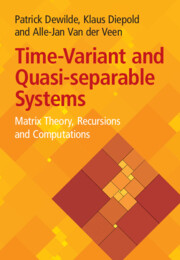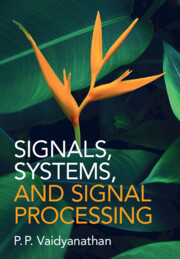Refine search
Actions for selected content:
6829 results in Communications and signal processing
6 - Signal Space Representation
-
- Book:
- Digital Communications
- Published online:
- 22 November 2024
- Print publication:
- 31 October 2024, pp 180-246
-
- Chapter
- Export citation
Index
-
- Book:
- Digital Communications
- Published online:
- 22 November 2024
- Print publication:
- 31 October 2024, pp 512-518
-
- Chapter
- Export citation
Preface
-
- Book:
- Time-Variant and Quasi-separable Systems
- Published online:
- 24 October 2024
- Print publication:
- 31 October 2024, pp xi-xxii
-
- Chapter
- Export citation
Appendix E - Implementation of PAM Transmission in Software
-
- Book:
- Digital Communications
- Published online:
- 22 November 2024
- Print publication:
- 31 October 2024, pp 487-500
-
- Chapter
- Export citation
Part I - Lectures on Basics with Examples
-
- Book:
- Time-Variant and Quasi-separable Systems
- Published online:
- 24 October 2024
- Print publication:
- 31 October 2024, pp 1-2
-
- Chapter
- Export citation
Bibliography
-
- Book:
- Digital Communications
- Published online:
- 22 November 2024
- Print publication:
- 31 October 2024, pp 501-511
-
- Chapter
- Export citation
Contents
-
- Book:
- Time-Variant and Quasi-separable Systems
- Published online:
- 24 October 2024
- Print publication:
- 31 October 2024, pp v-x
-
- Chapter
- Export citation
6 - Elementary Operations
- from Part I - Lectures on Basics with Examples
-
- Book:
- Time-Variant and Quasi-separable Systems
- Published online:
- 24 October 2024
- Print publication:
- 31 October 2024, pp 87-94
-
- Chapter
- Export citation
8 - Inner−Outer Factorization
- from Part I - Lectures on Basics with Examples
-
- Book:
- Time-Variant and Quasi-separable Systems
- Published online:
- 24 October 2024
- Print publication:
- 31 October 2024, pp 115-135
-
- Chapter
- Export citation
3 - Digital Pulse-Amplitude Modulation
-
- Book:
- Digital Communications
- Published online:
- 22 November 2024
- Print publication:
- 31 October 2024, pp 54-111
-
- Chapter
- Export citation
Appendices
-
- Book:
- Digital Communications
- Published online:
- 22 November 2024
- Print publication:
- 31 October 2024, pp 386-500
-
- Chapter
- Export citation

Time-Variant and Quasi-separable Systems
- Matrix Theory, Recursions and Computations
-
- Published online:
- 24 October 2024
- Print publication:
- 31 October 2024

Signals, Systems, and Signal Processing
-
- Published online:
- 29 August 2024
- Print publication:
- 13 June 2024
-
- Textbook
- Export citation
8 - Difference Equations with Nonzero IC
-
- Book:
- Signals, Systems, and Signal Processing
- Published online:
- 29 August 2024
- Print publication:
- 13 June 2024, pp 324-346
-
- Chapter
- Export citation
4 - Digital Filters and Filter Structures
-
- Book:
- Signals, Systems, and Signal Processing
- Published online:
- 29 August 2024
- Print publication:
- 13 June 2024, pp 117-162
-
- Chapter
- Export citation
2 - Fundamentals of Signals and Systems
-
- Book:
- Signals, Systems, and Signal Processing
- Published online:
- 29 August 2024
- Print publication:
- 13 June 2024, pp 10-61
-
- Chapter
- Export citation
Dedication
-
- Book:
- Signals, Systems, and Signal Processing
- Published online:
- 29 August 2024
- Print publication:
- 13 June 2024, pp v-vi
-
- Chapter
- Export citation
10 - Sampling a Continuous-Time Signal
-
- Book:
- Signals, Systems, and Signal Processing
- Published online:
- 29 August 2024
- Print publication:
- 13 June 2024, pp 410-457
-
- Chapter
- Export citation
9 - The Continuous-Time Fourier Transform
-
- Book:
- Signals, Systems, and Signal Processing
- Published online:
- 29 August 2024
- Print publication:
- 13 June 2024, pp 347-409
-
- Chapter
- Export citation
13 - The Laplace Transform
-
- Book:
- Signals, Systems, and Signal Processing
- Published online:
- 29 August 2024
- Print publication:
- 13 June 2024, pp 556-575
-
- Chapter
- Export citation
